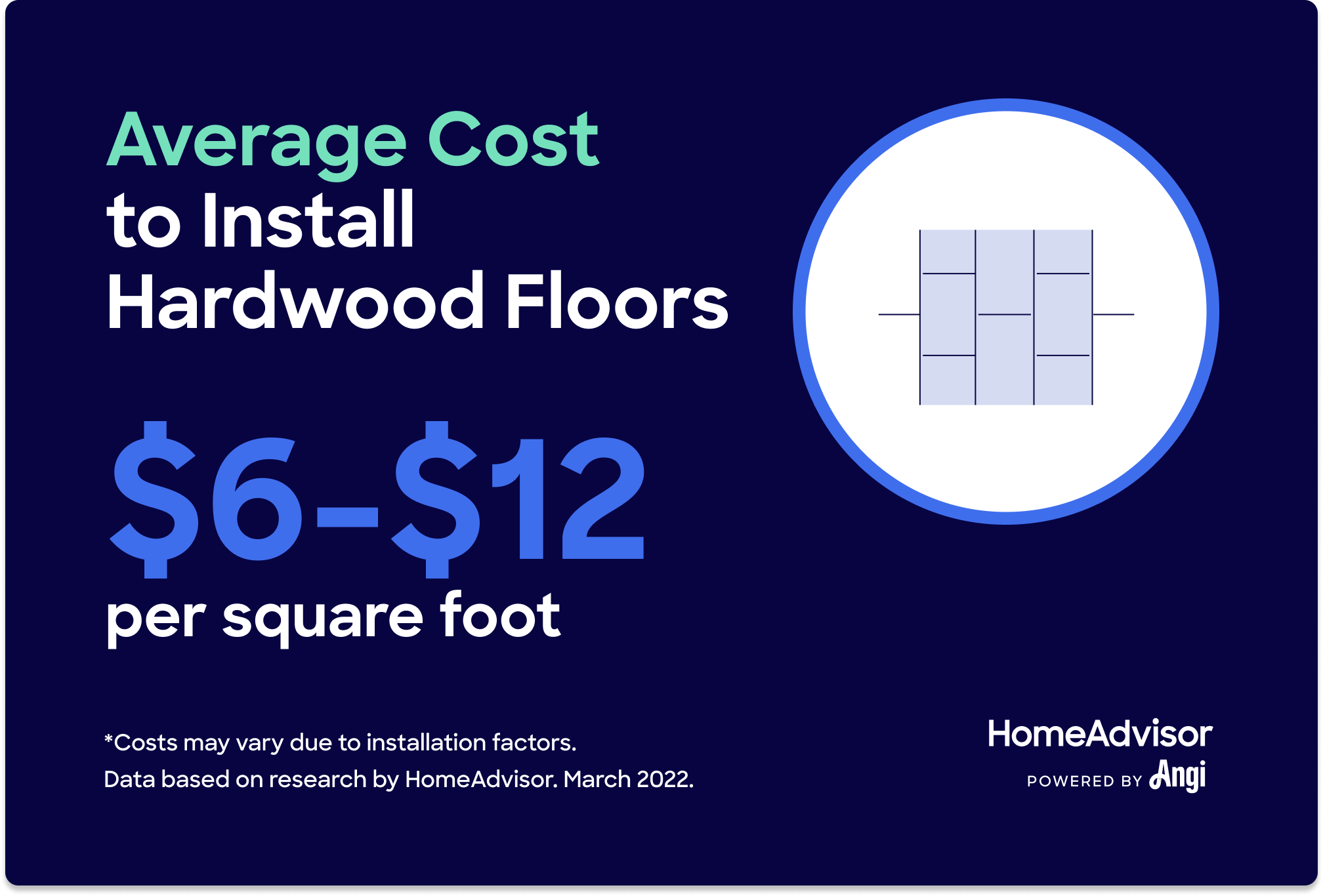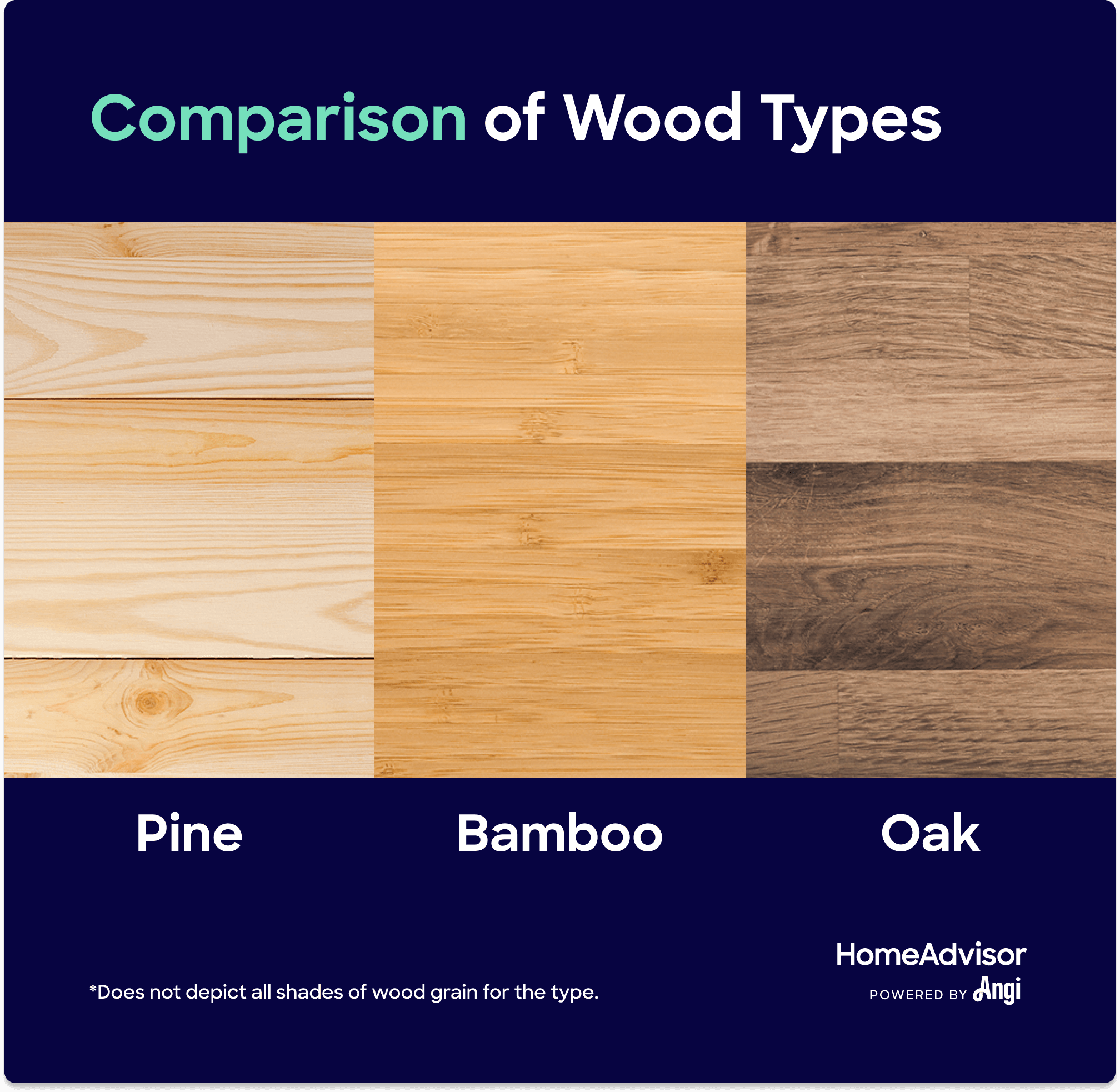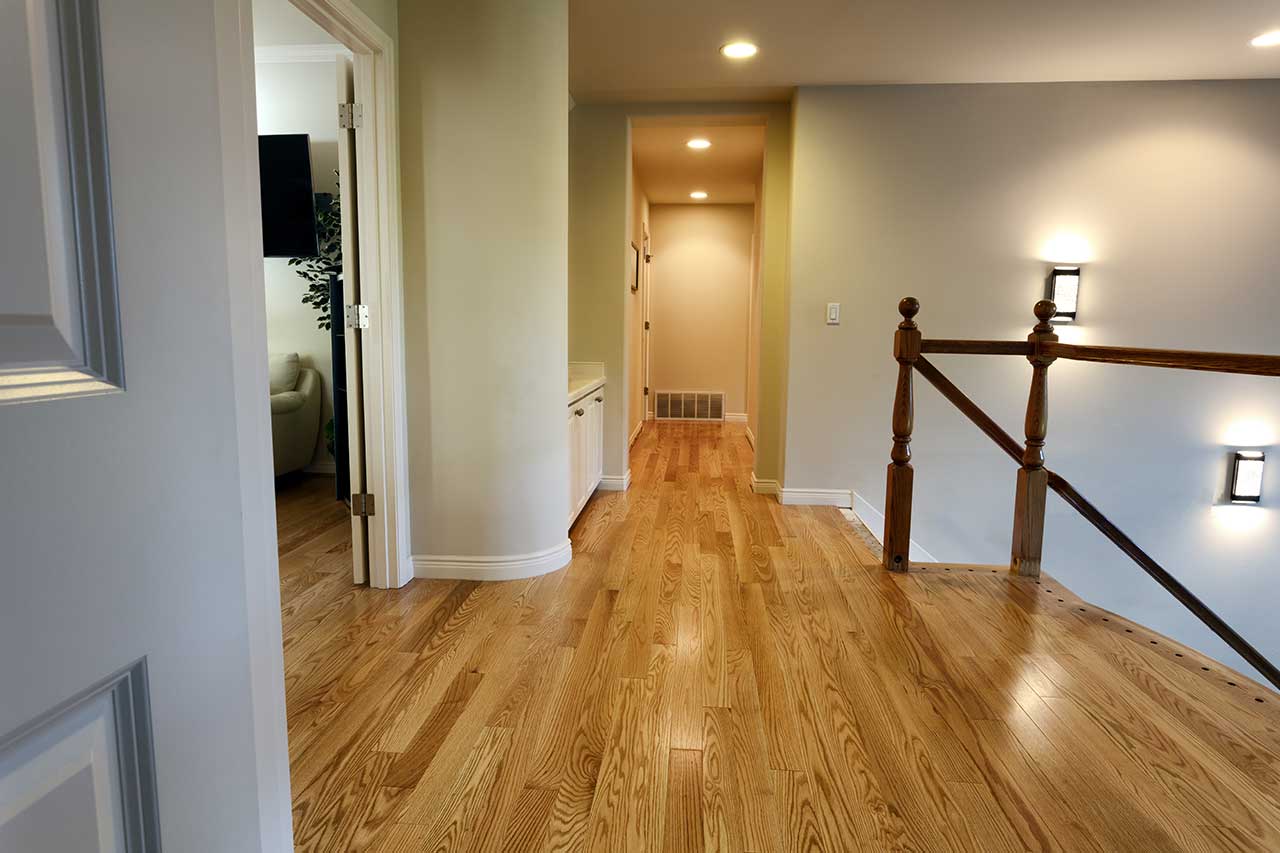How Much Does It Cost to Install Hardwood Floors?
Typical Range:
$2,483 - $7,026
Typical Range:
$2,483 - $7,026
Cost data is based on actual project costs as reported by 10,321 HomeAdvisor members. Embed this data
.
.
.
.
.
.
.
.
.
.
.
.
.
.
.
.
.
.
.
.
.
.
.
.
.
.
.
.
.
.
•
•
•
•
Updated December 14, 2022
Reviewed by Dan DiClerico, Smart Home Strategist and Home Expert.The total cost to install hardwood floors ranges from between $2,483 and $7,026, or $4,723 on average.
About 50% to 75% of your budget will go toward materials, with the rest spent on labor.
The most significant variable on your price tag is the wood type you choose. While looks are important, the style and color you like shouldn't be your only considerations. The room's moisture and temperature levels can also play a large factor in a suitable wood type for your flooring. This cost guide will explore how both materials and finish can affect your final cost, as well as alternative options.
2022 Notice: Material Prices Are Surging
Demand for siding and other building materials has grown over the past year. And as a result, manufacturers are increasing materials prices. Prices have gone up 5% to 10% this year, and many parts of the country are experiencing long delivery times. If you're planning a building project, we recommend starting as early as possible in the season, preparing for potential price fluctuations, and allowing extra time to order materials.
Let's calculate cost data for you. Where are you located?
Where are you located?
| National Average | $4,723 |
| Typical Range | $2,483 - $7,026 |
| Low End - High End | $1,000 - $12,000 |
Cost data is based on actual project costs as reported by 10,321 HomeAdvisor members.
For standard hardwood floors, the wood material will account for more than half of the budget. An additional cost factor includes the labor required to install hardwood flooring in your home.
See the estimated average percentages your factors contribute to your total cost.
While hardwood is more expensive than other flooring options, it’s popular for its classic aesthetic. The most significant cost factor for your budget is the wood type you choose, with around 60% of your budget going toward materials. While looks are important, the style and color you like shouldn't be your only considerations. The room's moisture and temperature levels can also play a large factor in a suitable wood type for your flooring.
The labor required to install hardwood flooring is the next most expensive cost factor. Most pros include removing old floors and installing new floors and trim in the project total. Consider the existing flooring, structure condition, and installation add-ons when determining your budget.
When finding hardwood floors, your budget will play a major role in determining how much you can get for your money. Whether you opt for affordable pine to the more durable Brazilian hardwood, select the cost range that best suits your needs to get started.
Most hardwood flooring installers charge between $6 to $12 per square foot. High-end jobs may run as high as $13 to $25 or more per square foot.
Hardwood flooring comes from boards of solid wood milled from hardwood trees. While hardwood is more expensive than other flooring options, it’s popular for its classic, warm appearance. It also adds resale value and helps increase a home’s marketability. Higher-end hardwood floors can last generations if cared for properly.
"One of the biggest benefits of solid wood flooring is that it can be sanded and refinished multiple times, so it's most likely the last flooring you’ll ever have to buy for your home," says Dan DiClerico, Smart Home Strategist and Home Expert.
The cost of hardwood flooring varies by the wood type you choose. The chart below breaks down the price for some of the most popular wood types for flooring.
| Wood Type | Average Price Range per Sq. Ft. | Description |
|---|---|---|
| Pine | $4.50 – $10 | Rustic knot patterns; light beige to rich golden amber; dents easily |
| Bamboo | $5 – $11 | Sustainable wood; pale yellow to green; hard and durable |
| Hickory | $6 – $13 | Various colors; works well in high-traffic areas |
| Red oak | $8 – $13 | Reddish color; highly visible grain; durable |
| White oak | $8 – $15 | Highly visible grain; durable; creates a warm ambiance |
| White ash | $9 – $13 | Soft, light tan to pale gray; visible knots to clear grades; durable but hard to stain |
| Brazilian walnut | $11 – $20 | Exotic wood; hard and durable |
Pine is the most common softwood flooring option and costs around $4.50 to $10 per square foot. As the name implies, a softwood floor is typically softer than other hardwood floors. Eastern white pine is one of the most common varieties and has been used in New England homes for hundreds of years. In addition, this wood type typically costs less than true hardwood. Sometimes, pine is half the cost of oak and even less expensive than some vinyl flooring.
However, pine is usually not often stocked by hardware stores, so visiting a sawmill is your best bet. Keep in mind that as a softer wood, pine will get dented, dinged, and scratched more easily than other harder woods; it can also develop a patina, or darkening over time. Hardwood pine floors can hold up pretty well in a room that doesn’t see heavy traffic, like an attic, lasting for many years.
At around $5 to $11 per square foot, bamboo floor prices range on the less expensive end. They come from a fast-growing, renewable grass source and come pre finished, so they're ready to use without sanding, staining, or coating. Bamboo floors are moisture-resistant because they typically hold the moisture on the top surface, making liquid easy to wipe away. Also, it doesn't trap dust or mites, making it great for allergy sufferers.
Some downsides of bamboo include the fact that it can scratch easily. We recommend using lighter color planks because they have better durability since the heating process that darkens the wood also softens it up to 20%. Another factor to consider is that not all brands are eco-friendly. Some utilize manufacturing processes that diminish the environmental friendliness of the materials.
Hickory flooring costs around $6 to $13 per square foot, is sturdy, and will hold up well in high-traffic areas in your home. It’s one of the hardest North American hardwood species, meaning it’s less likely to dent than softer hardwoods like maple or walnut. Homeowners with children and pets might want to opt for hardwood flooring made of hickory, but keep in mind that it's not simple for a DIY-er to sand and cut the wood.
As added benefits, hickory comes in wider planks and longer lengths than some other hardwood. And once hickory hardwood flooring is properly sealed, keeping it clean is simple: Occasionally sweeping or vacuuming and mopping will do the trick.
Oak is an excellent hardwood for flooring in entryways and kitchens because it can handle heavy traffic. You can find stained red oak more than any other type of wood in American homes, costing around $8 to $13 per square foot.
In recent years, white oak has been favored, often installed in a herringbone pattern. It costs around $8 to $15 per square foot, and its neutral color makes it easy to stain a variety of colors. Red oak is a bit different from white oak because it has a shorter grain, doesn't stain as well, and is less water-resistant.
Ash might not be the most popular hardwood, but it's a favorite of homeowners with a modern aesthetic. It costs around $9 to $13 per square foot. Ash is bright with a swirly pattern, and there are two types: Chinese white ash and imported white ash.
Unfortunately, a beetle known as the emerald ash borer is killing off the ash tree population, meaning ash trees will become rare in a few years. For now, ash flooring is still available but often only in shorter lengths.
Walnut costs around $11 to $20 per square foot and is a very dense wood and popular material for furniture, wood paneling, and flooring. Both the American walnut and Brazilian walnut types are resistant to insects and mold. The colors of its sapwood and heartwood are very different, which means there are differences in color and grain from board to board. And because walnut has a warm feel from its dark and rich colors and grains, it's able to hide scratches and dents more easily than other hardwoods.
Most professionals install traditional wood flooring unfinished since it's ideal to stain, seal, and set in a specific pattern when all the planks or panels are in place. The styles below reference the pattern on your wood floors.
| Floor Patterns | Average Price Range per Sq. Ft. |
|---|---|
| Wide plank | $4.50 – $18 |
| Herringbone | $5 – $16 |
| Parquet-style tile | $7 – $10 |
| Wood-look tile | $10 – $20 |
| Parquet | $20 – $45 |
Most pros include removing old floors and installing new floors and trim in the overall price. Consider the existing flooring, structure condition, and installation add-ons when creating your budget. A few of the most common labor considerations to keep in mind include:
Replacing joists/plywood: It could significantly increase installation costs if the subfloor needs repairs or replacement.
Hardwood floor repair cost: $450–$1,550
Repairing joists cost: $40–$60 per sq. ft.
Repairing subfloors cost: $500–$720
Removing moldings and baseboards: Installers need to remove all molding, trim, and baseboards to install floors, which increases labor time.
Insulating underlay: Some homeowners may want to install vapor barriers and/or foam underlays under their bamboo flooring. Underlayment costs $2–$4 per sq. ft., including installation.
Staining: You can stain your flooring to match your current home design.
One of the biggest choices a homeowner has to make is whether they want to pay for hardwood or if they want to save money and use engineered wood. They must also decide between the many options in each category. When comparing these two wood types, there are both long-term and short-term considerations.
As the name implies, engineered wood is a manufactured product. It's made by binding pieces of scrap wood, real wood, sawdust, shredded wood fibers, and adhesives to create a stronger, more durable product than solid wood. While both solid wood and engineered wood both have their edges shaped to allow the boards to interlock, engineered hardwood is more affordable and stands up better to changing humidity levels.
| Engineered Wood Type | Average Price Range per Sq. Ft. | Description |
|---|---|---|
| Basic | $4.50 – $9 | Three core layers; veneer between 1/16- to 1/12-inch thick |
| Mid | $6 – $12 | Five-layer core; thicker veneer |
| High | $9 – $16 | Seven or more core layers; 1/6-inch or thicker veneer; often an exotic hardwood |
Here are a few of the most popular engineered flooring options, along with some unique characteristics of each.
Maple: Colors range from creamy white to rich red; can be fastened, glued down, or glued together
Heart pine: Has vintage charm with nail holes, gouges, and attractive knots
White ash: Interesting character with a variation of colors and grain patterns that hides imperfections well
Brazilian cherry: Exotic wood with warm red-brown tones and rich hues
Brazilian koa: Distinct orange color with rich, dark brown striping for a bold look
Acacia: Attractive contrasts of medium brown colors and interesting graining for a rustic or colonial look
Consult our comparison guide for more information if you’re debating between installing engineered wood floors or laminate flooring, or keep reading to find out about other flooring types compared to hardwood flooring.
Even less expensive than hardwood and engineered wood floors are laminate floors. The average cost is about $1 per square foot, whereas hardwood prices range from $3 to $7 per square foot. This usually includes the cost of underlay and adhesives.
Laminate floors are made of particleboard wood on the bottom, then an image layer followed by a transparent wear layer. They can be a great choice for homeowners who like the look of wood but don’t want to deal with the expensive price or high maintenance required. Laminate floors come in many styles and finishes, and they’re durable.
As with any flooring type, laminate has some inherent advantages and disadvantages compared to hardwood. Laminate floors are susceptible to moisture, meaning the floor base can swell if it gets wet. These floors also chip easily and aren't recommended for bathrooms or laundry rooms.
The cost to install carpet ranges from $800 to $2,800 and usually doesn’t include removing existing flooring or preparing the subfloor. Carpet has a short life span compared to hardwood flooring, which explains why hardwood flooring is much more expensive. While carpet is highly resistant to water damage, mold can form if moisture seeps below it. Carpets are also not a great choice for people who suffer from allergies. Hardwood floors are easier to clean and will not stain as easily as lighter carpet colors.
Wood-look tile is a style of ceramic tile flooring that has gained popularity because it looks and sometimes feels like natural hardwood flooring. Installing wood-look tile flooring costs around $3,900 on average in a 300-square-foot space. You may pay as little as $1,350, with larger jobs costing about $15,000. Wood tile is a durable, easy-to-maintain surface. But unlike natural hardwood floors, it can withstand moisture and humidity and doesn’t require periodic sanding or staining.
If you’re installing solid wood floors, don’t try it yourself. Improper installation not only looks bad but can warp, split, and shrink to leave gaps. Find a local hardwood flooring installer who’ll take the time and bring the experience to get your floors looking beautiful.
If you’re looking to save some money and want to try your hand at installing it on your own, use an engineered floating floor. They’re a bit more forgiving than hardwood and easy to fix any minor mistakes. However, if you don’t have a long weekend set aside to prep and install your new planks, hire a contractor.
Hardwood floors can last for generations, making it a great and permanent flooring option. You can also resand and refinish hardwood floors many times. Hickory, red oak, and Brazilian walnut are hardwood options that are especially durable and can withstand high-traffic areas.
The best time to replace your hardwood flooring is when you can see exposed nails, especially if they’re visible on more than 30% of your hardwood floor. Another sign is if your floorboards are moving. However, keep in mind that hardwood floors can last generations when properly installed and well-maintained, so you may not need to replace hardwood floors as often as other flooring options.
To calculate how much flooring you’ll need, first find the area of the room by multiplying the length by the width. Then, divide that figure by the area of each box of flooring. Add 10% to that figure for overage and waste.
Yes, hardwood floors can add resale value to your home, with a 70% to 80% return on investment rate. In fact, installing hardwood floors is one of the best ways to up your home's marketability. This is because if they’re properly maintained, hardwood floors are extremely durable and can last for generations.
Buyers typically prefer hardwood over carpet, but the type of room can influence flooring preferences. For example, while prospective homeowners prefer the look of hardwood floors, a kitchen or bathroom can benefit from tiles, which is easier to maintain and clean. Also, carpet can be ideal for upper-floor bedrooms since it helps to reduce noise, keeps the floors warmer, and provides more cushioning.


